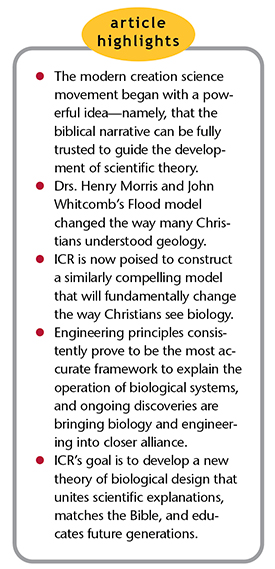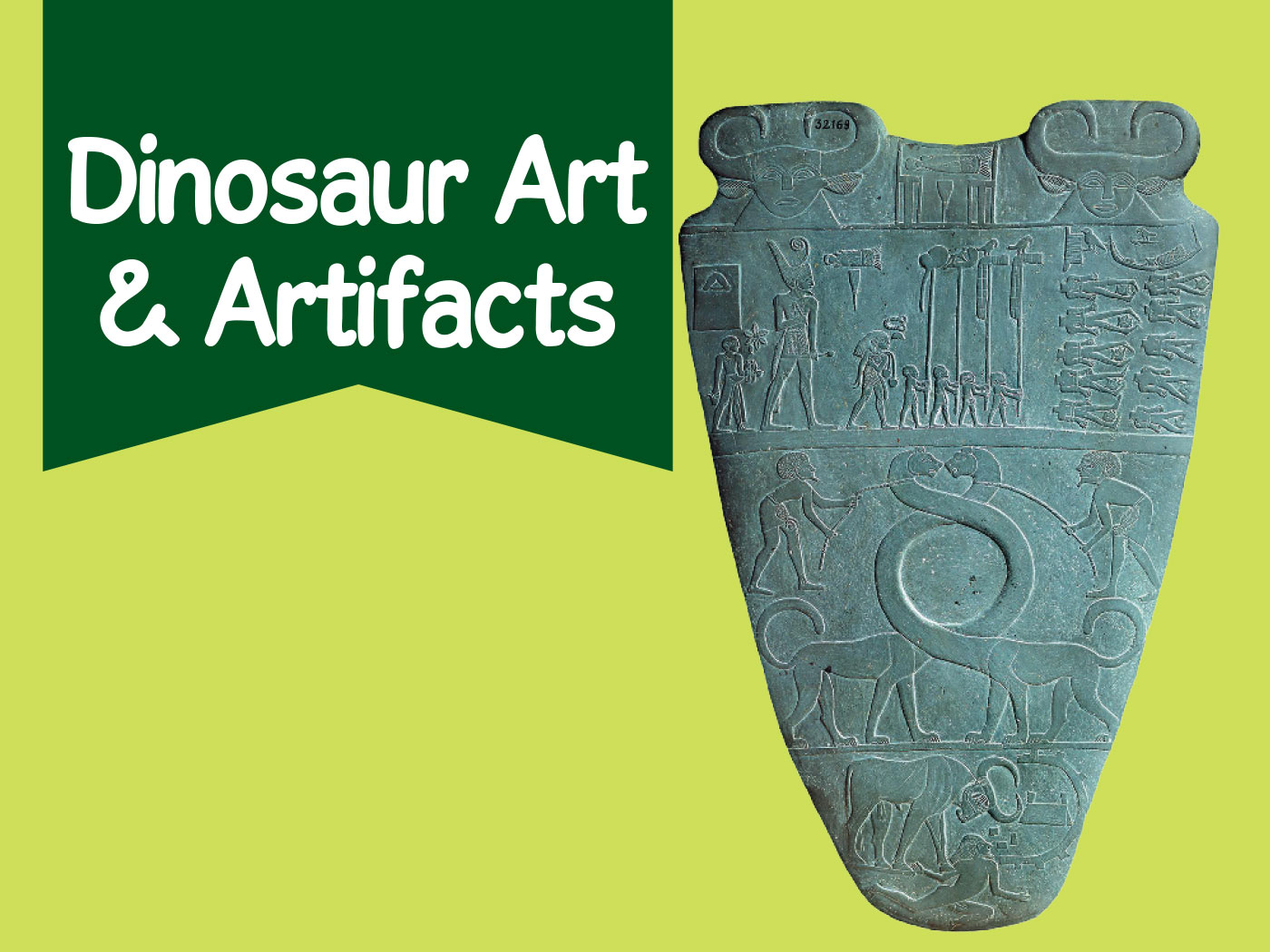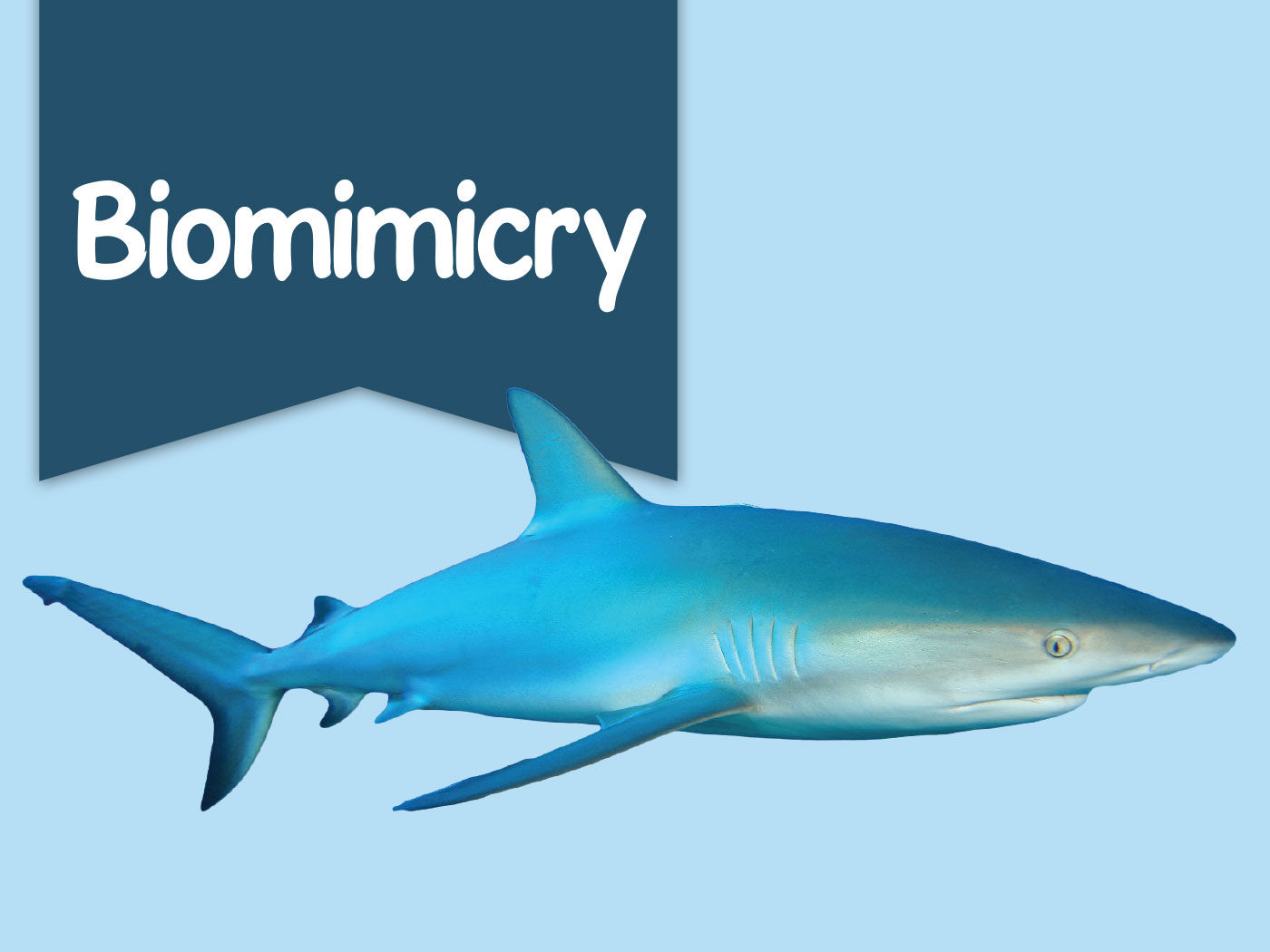 “Our task is to fundamentally change the way people understand biology by constructing a completely new theory of biological design that incorporates recent discoveries and respects the biblical narrative—all with the goal of igniting a second creationist revival.” That’s the short elevator pitch I give when asked what I want to accomplish as the president of the Institute for Creation Research.
“Our task is to fundamentally change the way people understand biology by constructing a completely new theory of biological design that incorporates recent discoveries and respects the biblical narrative—all with the goal of igniting a second creationist revival.” That’s the short elevator pitch I give when asked what I want to accomplish as the president of the Institute for Creation Research.
With the unanimous backing of our Board of Trustees, ICR is undertaking the biggest science initiative since we launched the Radioisotopes and the Age of the Earth (RATE) project in 1997. We often say that creationists and evolutionists have the same data, but our interpretations differ completely. ICR scientists believe our past endeavors to identify the abundant flaws in evolution were vital but are not nearly enough. Now is the time to state how and why the interpretation of biological phenomena must be profoundly different. Other skilled scientists and theorists agree and are ready to join us.
ICR’s History and the Power of an Idea
Just as the Flood model presented in Drs. Henry Morris and John Whitcomb’s The Genesis Flood changed the way many Christians understood geology, ICR’s highest priority today is to construct a similarly compelling model that will fundamentally change the way Christians—and, Lord willing, many others—see biology. The creation science movement was initially launched by a powerful idea: that the biblical narrative could be fully trusted to guide the development of scientific theory. This led to bolstering a theory of geology known as catastrophism through the exceptional explanatory power brought by the Flood model. Clearly, the Lord used the Christ-like nature of Henry Morris to advance creation science. That powerful idea, coupled with Dr. Morris’ gracious spirit, helped pastors have confidence in the Bible when theistic evolution was gaining influence in the church by leaps and bounds.
Our goal today is to build a clear, concise, and easily communicable biological framework that will spark a second creationist revival and again stir up a sense of certainty in Christian truth. We aim high for a goal that’s commensurate with the Lord Jesus’ power and proven enablement.
ICR has a team of scientists bold enough to study these observations in a radically new way and do the hard work necessary to connect these findings into a coherent theory. The resulting models wouldn’t be esoteric, mathematical constructs. They would compile hundreds of fascinating examples of creatures’ abilities and explain those biological functions from an organism-centered, engineering-based perspective that gives glory to the Creator—not to nature. A new theory of biological design would become the fundamental, design-based principle uniting biological explanations in Christian textbooks and museums to educate future generations of young believers.
Biology Comes Full Circle
As a pioneering research institute, ICR will be a leader in building a theory of biological design that’s fully informed by the biblical narrative right down to its basic assumptions. The timing couldn’t be better. Every day, the scientific literature reports on the operations of many new biological discoveries that are readily explained by principles of design. Across the field of biology, current research is demonstrating that the future of biology is heading back to two primary concepts.
First, there is an increasingly restored approach to the holistic view of creatures. In addition to the recognition that many creatures clearly seem to exercise independent agency, taking a holistic view means that we can’t fully understand how organisms function simply by looking at their parts. Rather, when taken as a whole, they have behaviors and actions that result from the purposeful arrangement of parts that is fundamentally distinct from the operation of the individual parts themselves. There are indications that essentially everything (e.g., molecules, parts, systems, etc.) about a creature seems to function not for a single purpose but for multiple purposes. These are innate capabilities derived solely from a creature’s internal systems.
Second is the mounting recognition in scientific papers that models based on mathematics and engineering principles consistently prove to be the most precise framework to explain the operation of biological systems. Pioneering biologists, though not speaking in today’s sophisticated engineering language, previously wrote extensively about the correspondence between the operation of human contrivances and features found in creatures. More recently, ICR invested nearly two years elaborating on these realities in a series of articles titled Engineered Adaptability in Acts & Facts.1 These articles introduced several of the concepts that are key to a theory of biological design but have yet to be fully developed.
The series demonstrated an innovative approach to biological explanations using engineering-based, organism-focused models. A model called continuous environmental tracking (CET) was created to explain the biological function of adaptation. CET is not simply a critique of the insufficiencies of adaptationism, random mutations, or selectionism. It’s a new model that flows from the latest findings in molecular biology—identifying innate sensing systems and logic mechanisms that direct targeted responses to environmental challenges.
Most importantly, this model gives clear and compelling reasons to fundamentally change the way we perceive organisms. An engineering-based, organism-focused framework shows why we should abandon Darwinism’s worldview of selectionism that sees organisms as modeling clay being passively shaped over time by nature.2 And that same design-based approach to biology shows why we should view creatures as active, problem-solving entities that continuously track changing environmental conditions and through innate systems purposefully adapt themselves over time to better fit existing niches or fill new ones.
A Rare Opportunity
Remarkably, the basic holistic and engineering premises that are increasing in biology today actually guided how pioneering scientists interpreted biological phenomena prior to biology being corrupted by Darwinism’s selectionist worldview. Over the last decade, many scientists have recognized that evolutionary theory is contradicted by the huge surge of biological discoveries that are suitably explained by engineering science principles. Evolutionists are currently in bitter disarray over whether they can reconcile these discoveries with Darwin’s theory.3
Recent trends in academia are adding to the upheaval. Technological developments and necessity are bringing biology and engineering into a very close association. Why? Because biologists methodically disassemble biological systems piece by piece to discover their operation; i.e., they have always been “reverse engineers.” The infusion of more engineering into biology is inevitable as both the number and importance of bioengineering departments swell at universities. In those buildings it’s difficult to draw a sharp distinction between a pure biologist and an engineer. Evolutionary biologists, who interpret biological observation through design-exclusive assumptions, will face the inevitable rising tide of scientific literature from other disciplines that are using engineering principles to better explain biological functions. Thus, we note increasing calls to reform or replace the current evolutionary framework, though the “reformers” themselves have not integrated a replacement.
Creation scientists have an extremely rare, transient opportunity to get out in front and frame all of these new findings before the evolutionists do. A theory of biological design would enable us to set both the interpretive and research agendas.
“Let the Dead Bury Their Dead”
For decades, creation scientists have focused primarily on exposing where evolutionary theory is insufficient, inconsistent, inaccurate, and incomplete. Both atheistic and theistic selectionists affirm that Darwin’s proposed mechanism is correct, but theistic selectionists add that it’s insufficient to explain the diversity of life. By merely tweaking or modifying evolutionary theory, they have essentially reinforced Darwin’s view...not replaced it.
A recent essay by Dr. Paul Nelson, an articulate advocate for research by the Intelligent Design (ID) community, perfectly summed up the need to move on from only attacking or tweaking evolutionary theory toward replacing it altogether. He did this in the context of a lecture he delivered about 20 years ago:
Following the talk, as I was packing up my computer, a young biochemist on the Wayne State faculty, who identified himself as a Christian (thus, he acknowledged, he was philosophically pre-disposed to find ID worthwhile, maybe), approached me at the podium. “You spent a lot of time in your talk criticizing evolutionary theory,” he began, “and I can agree with much of what you said. But what can you offer me using design (he asked) that I can take back to my lab and apply?” I have never forgotten his question, or my fumbling reply. It struck me that, indeed, nearly all of my talk had addressed shortcomings in evolutionary theory. By implication, the ID alternative was more promising—only I had said almost nothing about it.4
But today Nelson has come to realize “the abject futility of trying to construct a theory of biological design within a philosophical framework, naturalism, fundamentally committed to another goal. Reform it altogether, said Hamlet to the players.”4
There’s another crucial reason why we should “let the dead bury their own dead” (Luke 9:60) and move on entirely from Darwinian selectionism. It’s a mistake to think Darwin’s primary goal was to explain the cause for life’s diversity. Science historians clearly document that his goal was to explain why the purposeful parts and operations of creatures could look so incredibly designed without appealing to God as the designing agent.
Darwin is heralded for his great feat of explaining creatures’ “apparent design” by a totally materialist mechanism. Yet all he did was slip in a pseudo-agent—nature itself. He did this by personifying nature through his projection of “selective” abilities to the environment. Personifying nature as a selective entity bestows on it the capabilities of volition and intelligence, which it doesn’t have, so that it can function as an idolatrous substitute designer.5,6 ICR takes the task of exposing and opposing the “anti-Designer” goal of Darwinian selectionism very seriously since we must be “pulling down strongholds, casting down arguments and every high thing that exalts itself against the knowledge of God” (2 Corinthians 10:4-5).
Taking Action
I hope you’re feeling as energized for action as we are at being at the cutting edge of developing a new approach to biology that’s totally current, fully pro-life, and truly Christ-honoring. With the scientific insight and enablement of the Lord Jesus, ICR will move forward to seize this extraordinary opportunity. We would like to produce books, videos, and a textbook. To that end, we need an additional researcher and science writer. We ask you to partner with us on this important task.
I want to express a special “thank you” to everyone who attended the one-year anniversary celebration of the opening of ICR’s Discovery Center for Science & Earth History. Your presence was a joy to the entire ICR family!
Unfortunately, in our August issue we were harsh in our criticism of several fellow creation scientists and called them some names. I regret that we did that and am truly sorry for the hurt it inflicted. We will endeavor to not engage in those behaviors in the future. Please forgive us.
We are celebrating the 50 years that the Lord Jesus Christ has used the Institute for Creation Research to spearhead the biblical and scientific restraint against unchecked evolutionism and, more importantly, to proclaim the gospel! Like many of you, I marvel at how ICR’s influence in both the church and academia greatly exceeds our rather small size. We fully realize this is due to Christ’s enablement. Jesus reminds us in John 15 that He is the vine and we are the branches. We must abide in Him, for without Him we can do nothing. We appreciate that you also believe this. Thank you for abiding in Him as you have walked alongside us for all these years.
References
- Guliuzza, R. J. 2019. Engineered Adaptability: Continuous Environmental Tracking Wrap-Up. Acts & Facts. 48 (8): 17-19.
- Guliuzza, R. J. 2017. Engineered Adaptability: Adaptability via Nature or Design? What Evolutionists Say. Acts & Facts. 46 (9): 17-19.
- Guliuzza, R. J. Schism in Evolutionary Theory Opens Creationist Opportunity. Creation Science Update. Posted on ICR.org May 18, 2017, accessed September 6, 2020.
- Nelson, P. Reform It Altogether—More on the Naturalistic Parabola. Evolution News & Science Today. Posted on evolutionnews.org September 18, 2020, accessed September 19, 2020. Emphasis in original.
- Guliuzza, R. J. 2018. Engineered Adaptability: Darwin’s Anti-Design Doctrine. Acts & Facts. 47 (10): 17-19.
- Guliuzza, R. J. 2011. Darwin’s Sacred Imposter: Natural Selection’s Idolatrous Trap. Acts & Facts. 40 (11): 12-15.
* Dr. Guliuzza is President of the Institute for Creation Research. He earned his M.D. from the University of Minnesota, his Master of Public Health from Harvard University, and served in the U.S. Air Force as 28th Bomb Wing Flight Surgeon and Chief of Aerospace Medicine. He is also a registered Professional Engineer and holds a B.A. in theology from Moody Bible Institute.






















